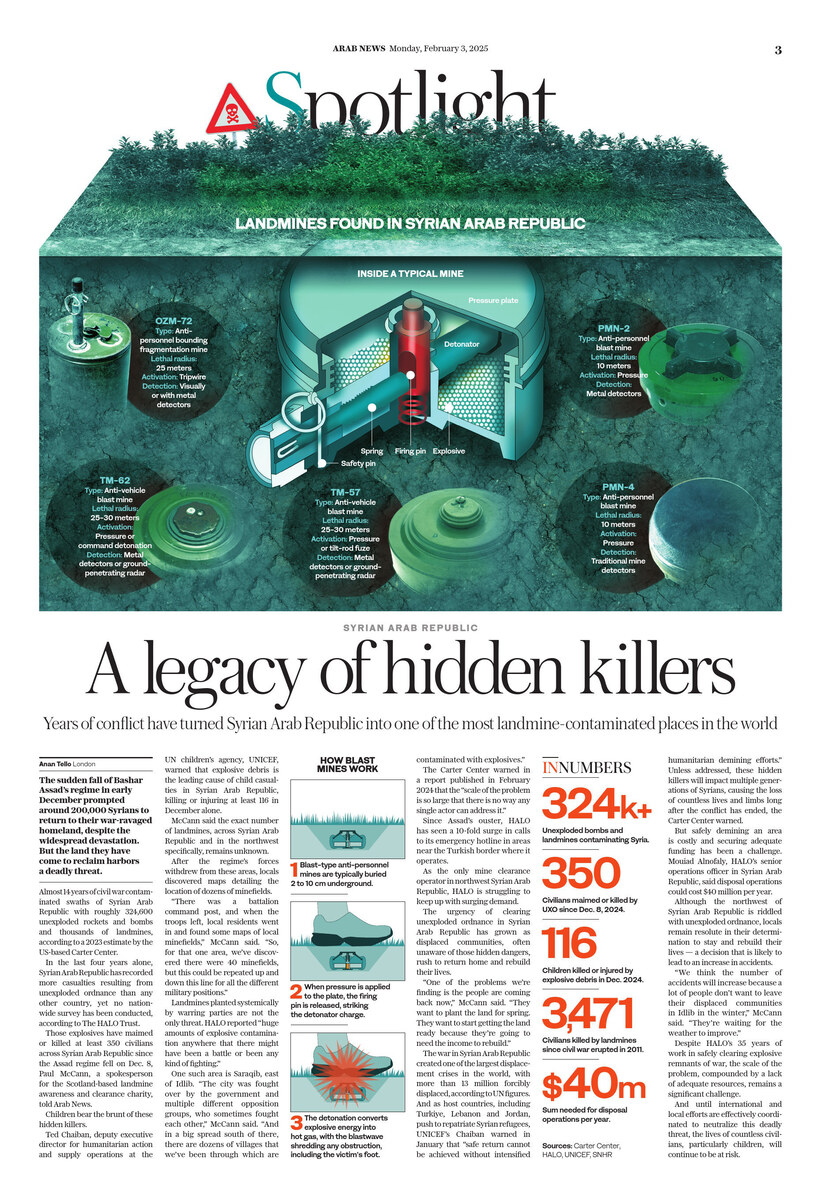NAIROBI: Human Rights Watch (HRW) on Monday accused the paramilitary Rapid Support Forces (RSF) and allied militias, at war with the army, of committing widespread sexual violence in southern Sudan.
It is the latest such report by international monitors alleging sexual violence during Sudan’s 20-month war which has led to what the United States called the world’s worst humanitarian crisis.
In its new report, HRW said it had documented dozens of cases since September 2023 involving women and girls aged between seven and 50 who were subjected to sexual violence, including gang rape and sexual slavery, in South Kordofan state.
The latest details follow a separate report last week from the New York-based watchdog which more broadly accused the RSF and allied Arab militias of carrying out numerous abuses, mainly against ethnic Nuba civilians, in South Kordofan state from December 2023 to March 2024.
These attacks, it said, “had not been widely reported” and constituted “war crimes.”
Parts of South Kordofan and parts of Blue Nile state are controlled by the Sudan People’s Liberation Movement-North (SPLM-N), a rebel group.
The SPLM-N faction led by Abdelaziz Al-Hilu refused to join other Sudan rebels in signing a 2020 peace deal with the government, as Hilu sought a secular state as a prerequisite.
Many South Kordofan residents are members of Sudan’s Christian minority.
Hilu also at that time refused talks with RSF leader Mohamed Hamdan Dagalo, linking him with atrocities.
SPLM-N has clashed with both the army and RSF in parts of South Kordofan since April, 2023 when the war between the paramilitaries and Sudanese Armed Forces began, HRW said.
The conflict has claimed the lives of tens of thousands of people, internally displaced more than eight million, according to the UN, and forced more than three million others to seek safety in neighboring countries.
According to the HRW report, many of the victims were gang-raped at their or their neighbors’ homes, often in front of families while some were abducted and held in conditions of enslavement.
One survivor, a 35-year-old Nuba woman, described being gang-raped by six RSF fighters who stormed her family compound and killed her husband and son when they tried to intervene.
“They kept raping me, all six of them,” she said.
Another survivor, aged 18, recounted being taken in February with 17 others to a base where they joined 33 detained women and girls.
“On a daily basis for three months, the fighters raped and beat the women and girls, including the 18-year-old survivor, crimes that also constitute sexual slavery,” HRW said.
At times, the captives were even chained together, it said.
“These acts of sexual violence, which constitute war crimes... underscore the urgent need for meaningful international action to protect civilians and deliver justice,” HRW said in its report.
The UN’s humanitarian chief Tom Fletcher raised the alarm late in November over an “epidemic of sexual violence” against women in Sudan, saying that the world “must do better.”
In October, the United Nations Independent International Fact-Finding Mission for the Sudan said both sides have committed abuses including torture and sexual violence. But it accused the paramilitaries, in particular, of “sexual violence on a large scale.”
These included “gang rapes and abducting and detaining victims in conditions that amount to sexual slavery,” the mission said.
In its initial report last week, HRW urged the UN and African Union to “urgently deploy a mission to protect civilians in Sudan.”
HRW accuses Sudan paramilitaries of widespread sexual violence
https://arab.news/rk4yb
HRW accuses Sudan paramilitaries of widespread sexual violence

- It is the latest such report by international monitors alleging sexual violence during Sudan’s 20-month war
- HRW said it had documented dozens of cases since September 2023 involving women and girls
Baghdad’s newly opened skate park offers safe space Iraqi youth have longed for

- The facility, located within the Ministry of Youth and Sports complex near Al-Shaab International Stadium, was completed in three weeks with support from the German and French embassies
BAGHDAD: Car bombs and militant attacks are no longer a daily concern in the streets of Baghdad as they were in the chaotic years after the fall of Saddam Hussein, or at the height of the battle to push back the Daesh group.
But while violence has decreased, many young Iraqis say their opportunities remain limited.
Baghdad, a city of nearly 9 million, has seen some efforts to restore public parks and cultural spaces, but urban planning has largely overlooked youth-focused projects.
That may be starting to change.
The capital inaugurated its first skate park this weekend at a ceremony attended by foreign diplomats, sports officials and young athletes, in what many hope will be the beginning of a drive to build more spaces for recreation and creative expression.
“I have been waiting for this moment for five years,” said Mohammed Al-Qadi, 19, one of the park’s first visitors on Saturday.
Al-Qadi, like many skateboarders in Baghdad, used to practice in public spaces such as Al-Zawraa Park and Abu Nawas Street, where skaters were often chased off by authorities, risked colliding with cars and faced safety risks due to uneven terrain and lack of designated areas.
“Before, we were often forced to move or got injured because there were no proper places for us,” he said. “Now, we have a safe space, and I hope this is just the beginning.”
The facility, located within the Ministry of Youth and Sports complex near Al-Shaab International Stadium, was completed in three weeks with support from the German and French embassies.
The project underscores growing international interest in developing Iraq’s sports infrastructure, particularly for activities beyond the country’s traditional focus on soccer.
Al-Qadi and other enthusiasts are now pushing for the formation of a national skating federation that could pave the way for participation in international competitions, including the Olympics.
“We have 25 male and female skaters now, but with this park, that number will definitely grow,” Al-Qadi said.
The skate park also sparked enthusiasm among female skaters, despite lingering societal resistance to girls participating in the sport seen as rough and sometimes dangerous.
“I hope to compete internationally now that we finally have a place to train,” said Rusul Azim, 23, who attended the opening in sportswear and a hijab.
Skating remains far less popular in Iraq than soccer and other mainstream sports, but Azim said she believes the new facility will encourage more young people — especially women — to take up the activity.
Zainab Nabil, 27, also came to the opening of the park despite the fact that her family disapproves of her skating.
“I am here to show that women belong in this sport too,” she said, adding, “I hope there will be separate days for women and men, so more girls feel comfortable joining.”
For now, the skate park stands as a small but significant step toward providing Iraq’s youth with a place of their own. Many hope it will be the first of many.
“We need more places like this — safe spaces where young people can be active, express themselves, and dream of something bigger,” Al-Qadi said.
US-backed commander says his Kurdish-led group wants a secular and civil state in post-Assad Syria

- The Assad family’s 54-year rule in Syria came to an end in early December when insurgents led by the Islamist Hayat Tahrir Al-Sham, or HTS, captured Damascus
HASSAKEH, Syria: The commander of the main US-backed force in Syria said Sunday the recent ouster of the Assad family from power should be followed by building a secular, civil and decentralized state that treats all its citizens equally no matter their religion or ethnicity.
The commander of the Kurdish-led Syrian Democratic Forces, Mazloum Abdi, said in an interview Sunday that he recently met with Syria’s newly named interim President Ahmad Al-Sharaa in Damascus. He said the two sides are negotiating with the help of mediators to find compromises regarding Syria’s future — including the future of the Kurds.
Abdi added that US troops should stay in Syria because the Daesh group will benefit from a withdrawal, which would affect the security of the whole region.
A new leader chosen after the fall of Assad
The Assad family’s 54-year rule in Syria came to an end in early December when insurgents led by the Islamist Hayat Tahrir Al-Sham, or HTS, captured Damascus. The fall of Bashar Assad on Dec. 8. came after a nearly 14-year conflict that has killed half a million people and displaced half the country’s population.
Syrian factions that toppled Assad met in Damascus last week and named HTS leader Al-Sharaa as the country’s interim president. The groups suspended the country’s constitution adopted by Assad in 2012 and officially dissolved the army and Syria’s dreaded security agencies.
“The fall of the regime was a historic step and based on that a new Syria should be built without restoring the Baath party or its ideology,” Abdi said referring to Assad’s once ruling Baath party that was also dissolved last week. “We want to move Syria forward together.”
‘The matter was not discussed with us’
Asked about the meeting in Damascus last week in which Al-Sharaa was named interim president while the parliament, constitution and the army were dissolved, Abdi said: “We were not present there and we will not comment.”
“The matter was not discussed with us,” Abdi said adding that there are negotiations between Al-Sharaa and the SDF and “our stance will be based on the results of the negotiations.”
Abdi said that visits by SDF officials to Damascus will continue to try to reach an understanding with the new authorities. “We will continuously try to see how Syria of the future will look like,” Abdi said, adding that the vision of the SDF is based on dialogue and understanding.
Abdi revealed that members of the US-led coalition to fight the Daesh group, including the US, Britain and France, are mediating between the SDF and authorities in Damascus. He did not go into details.
Abdi said his group wants Syria to remain a united country with a central government in Damascus.
“Our vision of Syria is a decentralized, secular and civil country based on democracy that preserves the rights of all of its components,” he said referring to the country’s different religious groups, such as Sunni Muslims, Christians, Alawites, Druze and Yazidis and ethnic groups such as Arabs, Kurds, Turkmen and Armenians.
“Syria is mixed and is not made up of Sunnis only. There are other identities,” Abdi said referring to the country’s Sunni Muslims who are the majority in the country. There have been concerns that HTS, which is rooted in the Salafi-jihadi ideology, might be working on turning Syria into an Islamic state, although in recent years Al-Sharaa has distanced himself from the group’s earlier stances and preached religious coexistence.
Kurds want a decentralized state but not autonomy
Abdi said the Kurds of Syria do not want to break away from the country or set up their own autonomous government and parliament as is the case in northern Iraq. He said the people of northeast Syria want to run their local affairs in a decentralized state.
“Syria is not Iraq and Iraq is not Syria and northeast Syria is not (Iraq’s) Kurdistan,” Abdi, whose forces control 25 percent of Syria, said.
Most of the country’s former insurgent factions have agreed to dissolve and to become part of the new army and security services, although it remained unclear exactly how that will work in practice. The SDF has not so far agreed to dissolve.
Asked whether he is ready to dissolve the SDF, Abdi said that in principle they want to be part of the defense ministry and part of Syria’s defense strategy. He said the details still need to be discussed and they have sent a proposal regarding this issue to Damascus and “we are waiting for the response.”
He said the SDF fighters have been fighting IS for 12 years and the rights of his fighters should be guaranteed.
US troops should stay in Syria
Speaking about IS, which his group played a major role in defeating, Abdi said that the extremists took advantage after the fall of Assad and captured large amounts of weapons from posts abandoned by Assad’s forces.
Abdi said US troops should stay in Syria because they are needed in the fight against IS.
In 2019, President Donald Trump decided on a partial withdrawal of US troops form the northeast before he halted the plans. “The reason for them (US troops) to stay is still present because Daesh is still strong,” Abdi said, using an Arabic acronym to refer to IS.
“We hope that the coalition does not withdraw,” Abdi said, adding that they are not aware of any US plans to withdraw from Syria. “We ask them to stay.”
Algeria’s president sacks finance minister, state TV says

ALGIERS: Algeria’s President Abdelmadjid Tebboune sacked his Finance Minister Laaziz Faid on Sunday, without giving details on the reasons behind the decision, state TV reported.
Tebboune appointed Abdelkrim Bou El Zerd to replace him.
New Syria leader faces territorial, governance hurdles

- In his first address as president Thursday, he vowed to “form a broad transitional government, representative of Syria’s diversity” that will “build the institutions of a new Syria” and work toward “free and transparent elections”
DAMASCUS: The ousting of Bashar Assad ended decades of iron-fisted rule, but despite power now resting in Ahmed Al-Sharaa’s hands, Syria faces a fragile transition amid territorial and governance challenges.
Military commanders appointed Sharaa interim president weeks after Islamist-led rebel forces overran Damascus.
His nomination has been welcomed by key regional players Egypt, Qatar, Turkiye and Saudi Arabia.
Syrians are “now fully dependant” on the intentions of the new authorities over the future of their country, said Damascus-based lawyer Ezzedine Al-Rayeq.
“Will they really take the country toward democracy, human rights?” he asked.
Sharaa led the Islamist Hayat Tahrir Al-Sham group, which spearheaded the rebel offensive that toppled Assad on December 8.
The group and other factions have been dissolved, with fighters set to be integrated into a future national force.
Sharaa has now traded his fatigues for a suit and a tie.
In his first address as president Thursday, he vowed to “form a broad transitional government, representative of Syria’s diversity” that will “build the institutions of a new Syria” and work toward “free and transparent elections.”
Sharaa had already been acting as the country’s leader before Wednesday’s appointment, which followed a closed-door meeting with faction leaders who backed the overthrow of Assad.
Rayeq said he wished the presidential nomination had been made “in a more democratic, participatory way.”
Authorities have pledged to hold a national dialogue conference involving all Syrians, but have yet to set a date.
“We thought that the national conference would see the creation of (new) authorities and allow the election of a president — perhaps Sharaa, or someone else,” Rayeq said.
“But if we are realistic and pragmatic, (appointing Sharaa) was perhaps the only way forward,” said Rayeq, who since Assad’s fall has helped found an initiative on human rights and political participation.
Authorities have suspended the constitution and dissolved parliament, while the army and security services collapsed after decades of Baath party rule.
Ziad Majed, a Syria expert and author on the Assad family’s rule, said Sharaa’s appointment “could have been negotiated differently.”
“It’s as if the heads” of the different armed groups chose Sharaa, Majed said, while noting the leader was effectively “already acting as a transitional president.”
Sharaa said his appointment followed “intense consultations” with legal advisers, promising a “constitutional declaration” and a “limited legislative council.”
Majed said most armed groups “recognize Sharaa’s leadership,” but noted unresolved tensions with fighters in the south and northeast.
Armed groups in the southern province of Sweida, including from the Druze minority, have been cautious about the new authorities, though two groups said last month they were ready to join a national army.
In the north and northeast, the Kurdish-led Syrian Democratic Forces from a semi-autonomous Kurdish administration have been battling pro-Turkiye fighters.
Syria’s new rulers, also backed by Ankara, have urged the SDF to hand over its weapons, rejecting any Kurdish self-rule.
Majed said he expected “Sharaa and those close to him” to seek to “consolidate territorial control and control over armed groups,” but that other priorities would include reviving the war-battered economy.
He also cited sectarian challenges and the need for efforts to avoid “acts of revenge,” particularly against members of the Alawite community, from which the Assads hail.
Lawyer Rayeq said he supported grouping Syria’s ideologically diverse armed groups “under a single authority, whatever it is.”
If such a move were successful, “we will have put the civil war behind us,” he said.
Assad’s toppling has finally allowed Syrians to speak without fear, after years of repression, but concerns remain.
Dozens of Syrian writers, artists and academics have signed a petition urging “the restoration of fundamental public freedoms, foremost among them the freedoms of assembly, protest, expression and belief.”
The petition also called for the right to form independent political parties and said the state must not “interfere in people’s customs,” amid fears Islamic law could be imposed.
Spare car parts seller Majd, 35, said the authorities’ recent announcements were “positive,” but expressed concern about the economy.
“Prices have gone down, but people don’t have money,” he told AFP from a Damascus park with his family, noting hundreds of thousands of civil servants had been suspended from work since Assad’s overthrow.
Near the capital’s famous Ummayad square, vendors were selling Syrian flags, some bearing Sharaa’s image.
“It’s too early to judge the new leadership,” Majd said, giving only his first name.
He said he preferred to wait to see the “results on the ground.”
Explosive remnants of Syrian civil war pose a daunting challenge

- Unexploded ordnance and landmines threaten civilians, with children most at risk of death or injury
- As displaced Syrians return, accidents are expected to rise due to inadequate clearance, experts warn
LONDON: The sudden fall of Bashar Assad’s regime in early December prompted around 200,000 Syrians to return to their war-ravaged homeland, despite the widespread devastation. But the land they have come to reclaim harbors a deadly threat.
Almost 14 years of civil war contaminated swathes of the Syrian Arab Republic with roughly 324,600 unexploded rockets and bombs and thousands of landmines, according to a 2023 estimate by the US-based Carter Center.
In the last four years alone, the Syrian Arab Republic has recorded more casualties resulting from unexploded ordnance than any other country, yet no nationwide survey of minefields or former battlefields has been conducted, according to The HALO Trust.
Those explosives have maimed or killed at least 350 civilians across the Syrian Arab Republic since the Assad regime fell on Dec. 8, Paul McCann, a spokesperson for the Scotland-based landmine awareness and clearance charity, told Arab News.
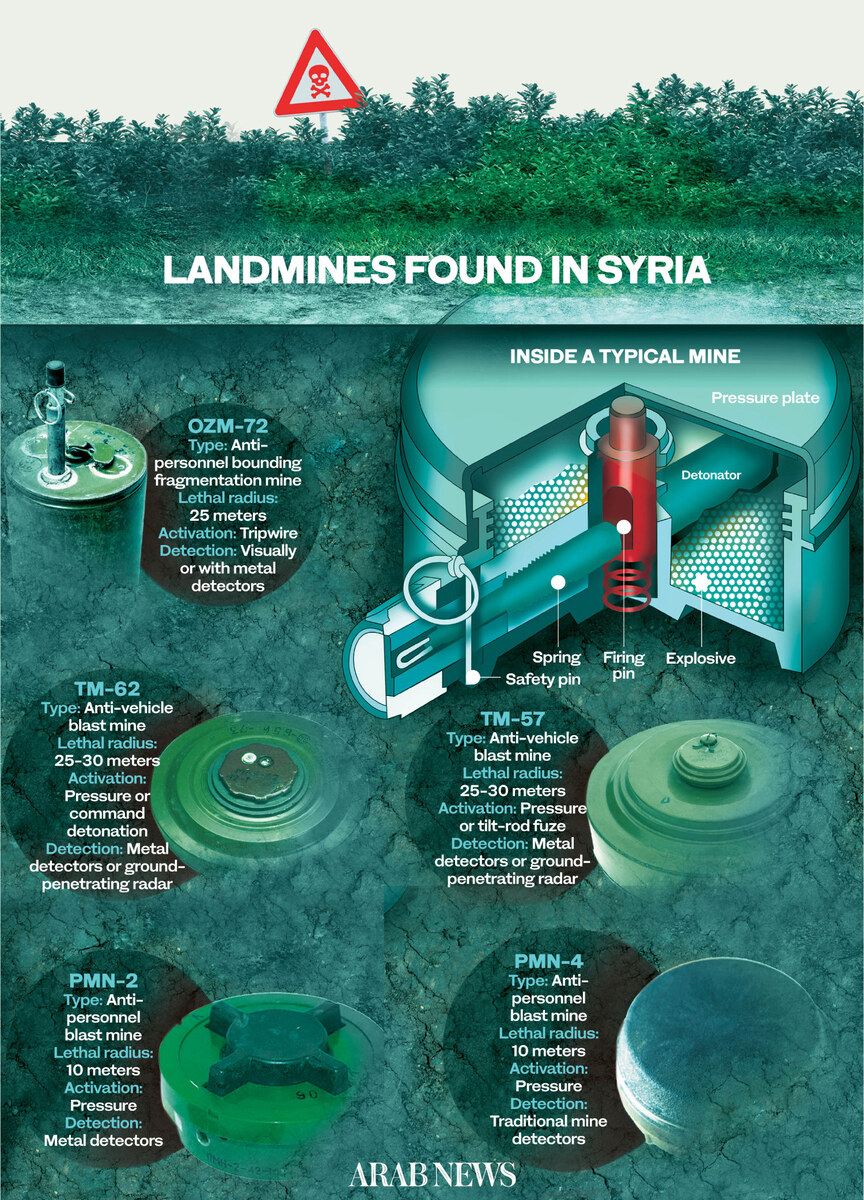
The actual toll, however, is likely much higher. “We think that’s an undercount because large areas of the country have no access or monitoring, particularly in the east,” he added.
Children bear the brunt of these hidden killers.
Ted Chaiban, deputy executive director for humanitarian action and supply operations at the UN children’s agency, UNICEF, warned that explosive debris is the leading cause of child casualties in Syria, killing or injuring at least 116 in December alone.
According to McCann, the bulk of the documented incidents involving landmines and unexploded ordnance took place in Idlib province, north of Aleppo, and Deir Ezzor, where intense battles between regime forces and opposition groups had occurred.
“There is a long frontline — maybe several hundred kilometers — running through parts of Latakia, Idlib, and up to north of Aleppo, where the government was on one side, and they built large earthen barriers,” he said.
“They used bulldozers to push up big walls and dig trenches, and in front of their military positions they put a lot of minefields.”
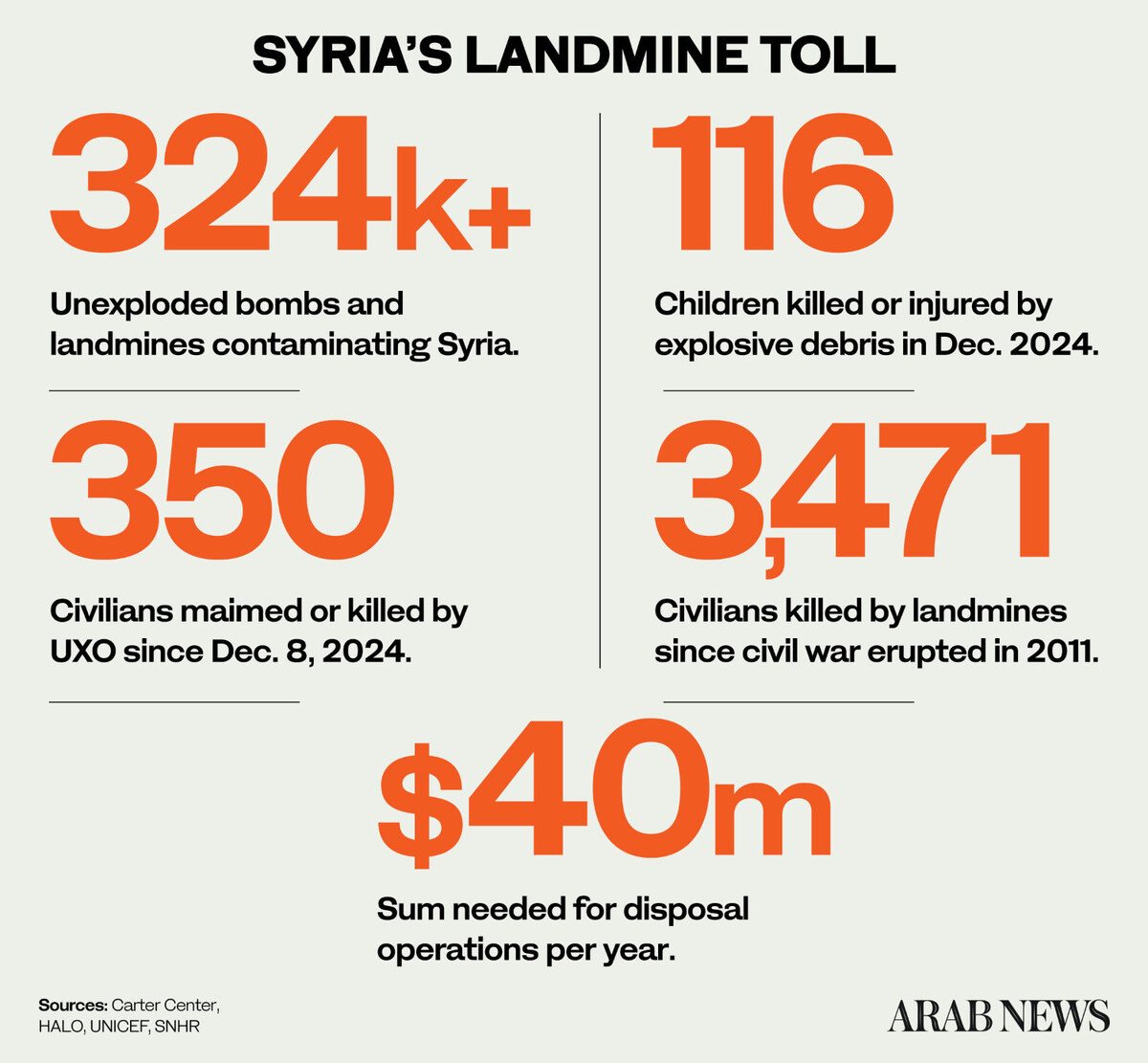
McCann said the exact number of landmines, across the Syrian Arab Republic and in the northwest specifically, remains unknown. “We don’t know exactly how many, because there hasn’t been a national survey,” he said.
After the regime’s forces withdrew from these areas, locals discovered maps detailing the location of dozens of minefields. Although it will take time and resources to clear these explosives, such maps make containment far easier.
“There was a battalion command post, and when the troops left, local residents went in and found some maps of local minefields,” McCann said. “So, for that one area, we’ve discovered there were 40 minefields, but this could be repeated up and down this line for all the different military positions.”
Landmines planted systemically by warring parties are not the only threat. HALO reported “huge amounts of explosive contamination anywhere that there might have been a battle or been any kind of fighting.”
One such area is Saraqib, east of Idlib. The northwestern city endured a major battle in 2013, fell to rebel forces, was recaptured by the Syrian Army in 2020, and was then seized during the Hayat Tahrir Al-Sham-led offensive on Nov. 30.
“The city was fought over by the government and multiple different opposition groups, who sometimes fought each other,” McCann said. “And in a big spread south of there, there are dozens of villages that we’ve been through which are contaminated with explosives.”
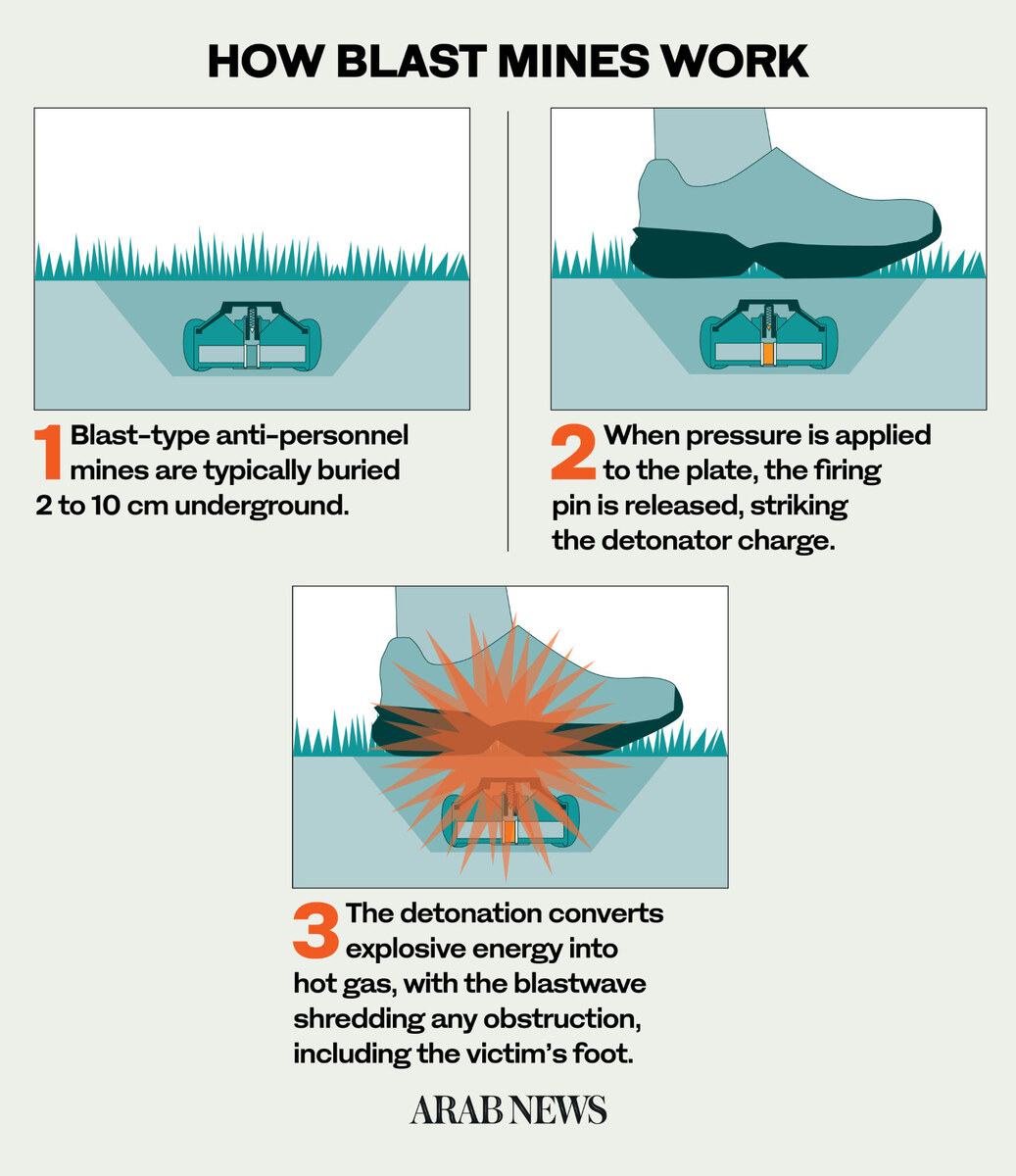
The Carter Center warned in a report published in February 2024 that the “scale of the problem is so large that there is no way any single actor can address it.”
Since Assad’s ouster, HALO has seen a 10-fold surge in calls to its emergency hotline in areas near the Turkish border where it operates.
“Every time our teams dispose of a piece of ordnance… people hear the explosion and they come running to say, ‘I found something in my house’ or ‘I found something on my land, can you come and have a look? Can you come and take care of that?” McCann said.
“We are hoping to be able to increase the size of the program as quickly as possible to deal with the demand.”
As the only mine clearance operator in northwest Syria, HALO is struggling to keep up with surging demand. With funding for only 40 deminers, the organization is desperately understaffed, HALO’s Syrian Arab Republic program manager Damian O’Brien said in a statement.
HALO urgently needs emergency funding “to help bring the Syrian people home to safety,” he said. “Clearing the debris of war is fundamental to getting the country back on its feet,” he added.
The urgency of clearing unexploded ordnance in Syria has grown as displaced communities, often unaware of those hidden dangers, rush to return home and rebuild their lives.
“One of the problems we’re finding is the people are coming back now,” McCann said. “They want to plant the land for spring. They want to start getting the land ready because they’re going to need the income to rebuild.
“Millions of homes have been either destroyed by fighting, or they’ve been destroyed by the regime that stripped out the windows and the doors and the roofs and the copper pipes and the wiring to sell for scrap.”
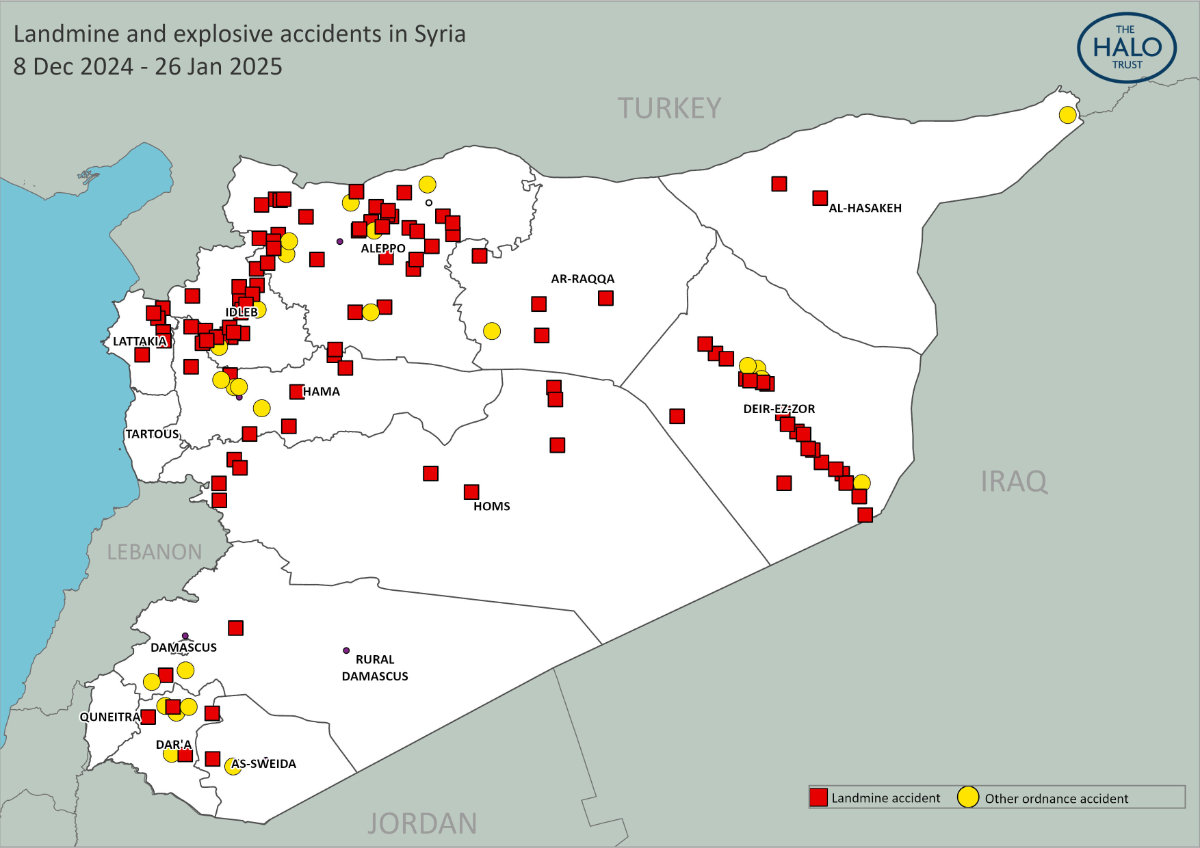
The war in the Syrian Arab Republic created one of the largest displacement crises in the world, with more than 13 million forcibly displaced, according to UN figures. With Assad’s fall, hundreds of thousands returned from internal displacement and neighboring countries.
And as host countries, including Turkiye, Lebanon and Jordan, push to repatriate Syrian refugees, UNICEF’s Chaiban warned in January that “safe return cannot be achieved without intensified humanitarian demining efforts.”
HALO’s O’Brien warned in December that “returning Syrians simply don’t know where the landmines are lying in wait. They are scattered across fields, villages and towns, so people are horribly vulnerable.”
He added: “I’ve never seen anything quite like it. Tens of thousands of people are passing through heavily mined areas on a daily basis, causing unnecessary fatal accidents.”
Unless addressed, these hidden killers will impact multiple generations of Syrians, causing the loss of countless lives and limbs long after the conflict has ended, the Carter Center warned.
Economic development will also be disrupted, particularly in urban reconstruction and agriculture. Environmental degradation is another concern. As munitions break down, they leach chemicals into the soil and groundwater.
But safely demining an area is costly and securing adequate funding has been a challenge. Mouiad Alnofaly, HALO’s senior operations officer in the Syrian Arab Republic, said disposal operations could cost $40 million per year.
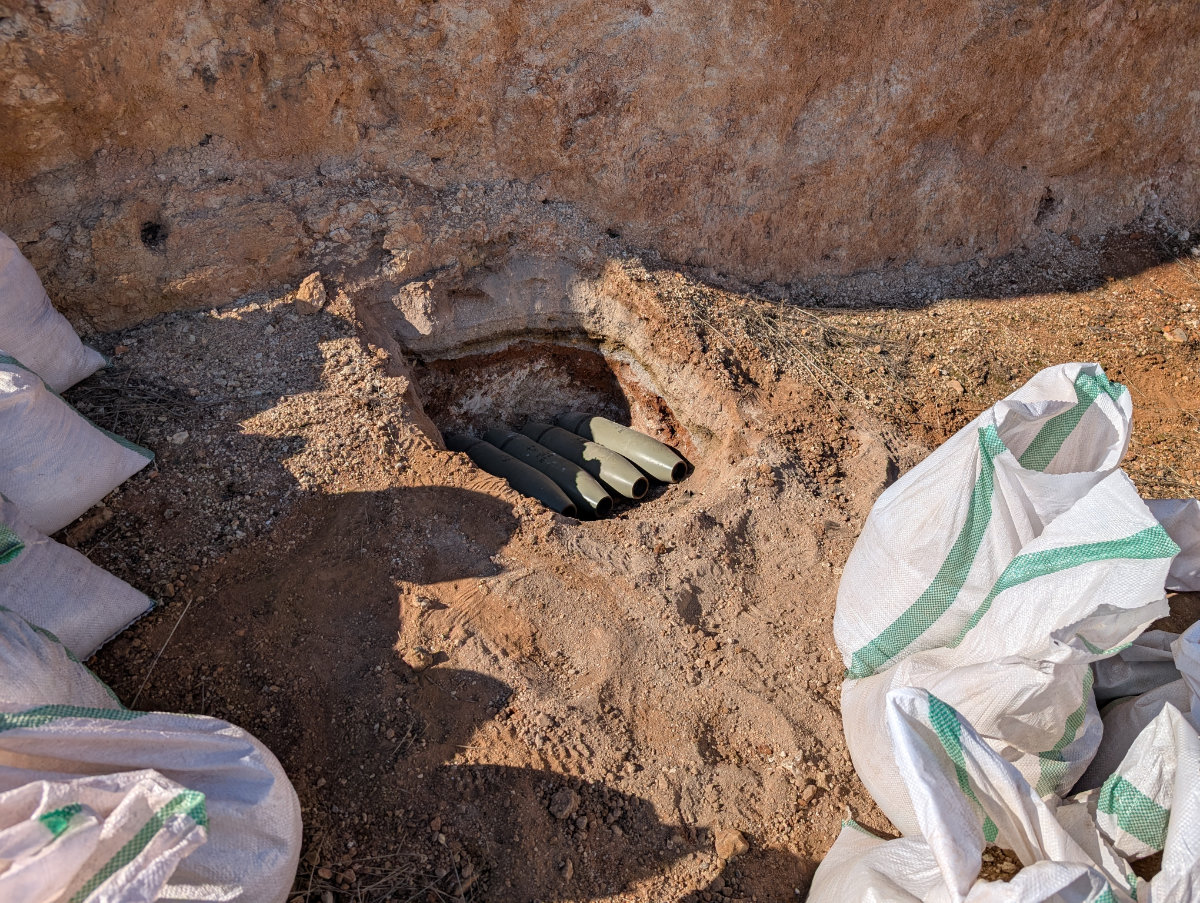
Faced with these limitations, locals eager to cultivate their farmland are turning to unofficial solutions, hiring amateurs who are not trained to international standards, resulting in more casualties, McCann warned.
“People are returning and trying to plant, and so we’re hearing reports that they’re hiring ex-military personnel with metal detectors to do some sort of clearance of their land, but it’s not systematic or professional,” he said.
“I met a man a few days ago who said his neighbor had hired an ex-soldier with a metal detector to find the mines on his land. The man (ex-soldier) was killed straight away, and the neighbor was injured.”
McCann emphasized that a field cannot be considered safe until every piece of explosive debris and every landmine has been removed.

“If there are 50 mines in a field, and somebody finds 49 of them, the field still cannot be used,” he said. “You can only hand back land when you are 100 percent confident that every single mine is gone.
“So, even in places where some people are removing mines, we don’t know if all of them have been cleared, and we’ll have to do clearance again in the future.”
Although the northwest of the Syrian Arab Republic is riddled with unexploded ordnance, locals remain resolute in their determination to stay and rebuild their lives — a decision that is likely to lead to an increase in accidents.
“We think the number of accidents will increase because a lot of people don’t want to leave their displaced communities in Idlib in the winter,” McCann said. “They’re waiting for the weather to improve.”
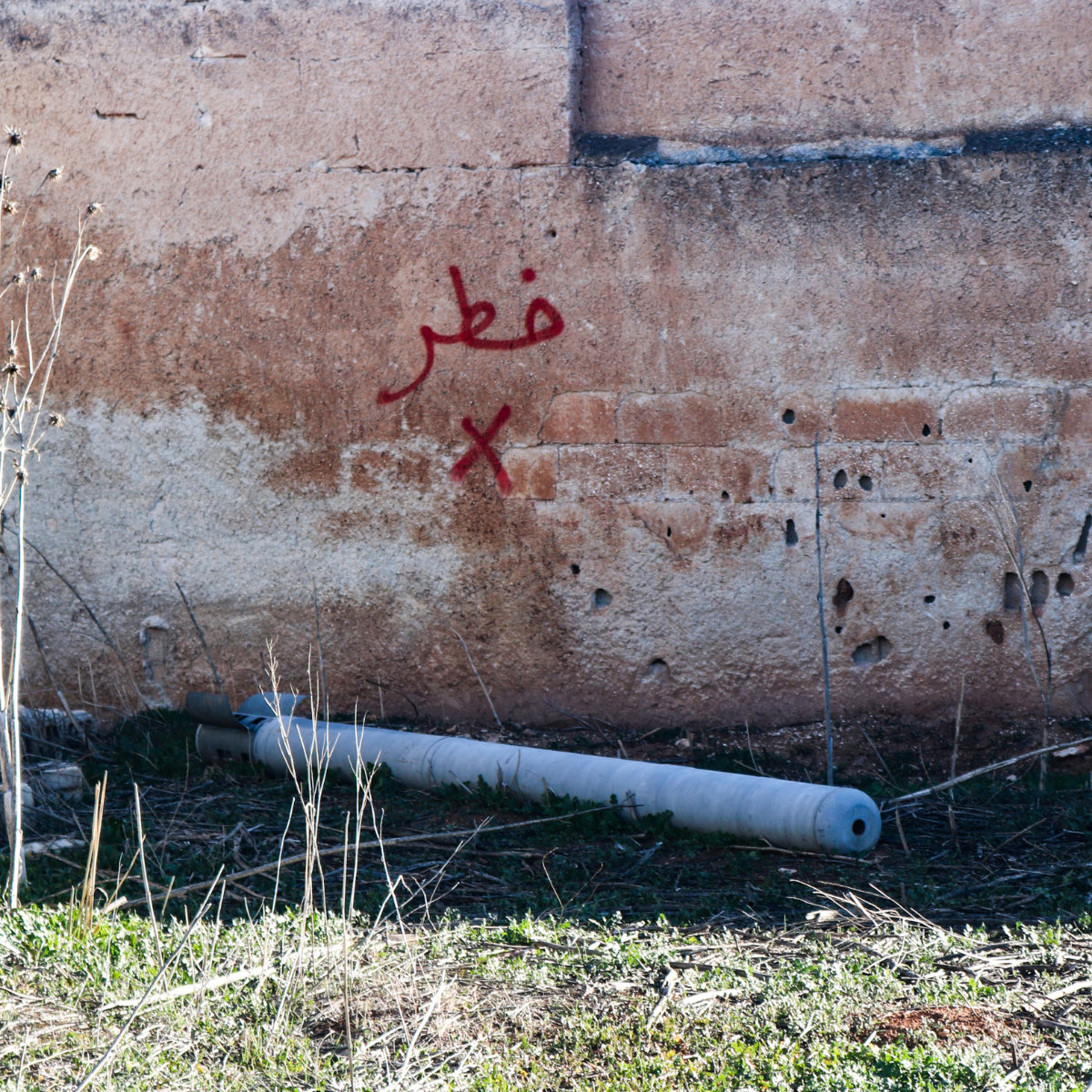
In the village of Lof near Saraqib, one resident HALO encountered returned to work on his land just hours after the charity’s team had neutralized an unexploded 220mm Uragan rocket. Had it detonated, it would have devastated the village.
“We took the rocket, dug a big hole, and evacuated the whole village,” McCann said. “We used an armored front loader to take it to this demolition site in the countryside.
“By the time we came back to the village, the landowner had started to rebuild his house where the rocket had been. He couldn’t touch it (before), and the rocket had been there probably since 2021.
“But within three or four hours of us removing the rocket, he had started to rebuild.”
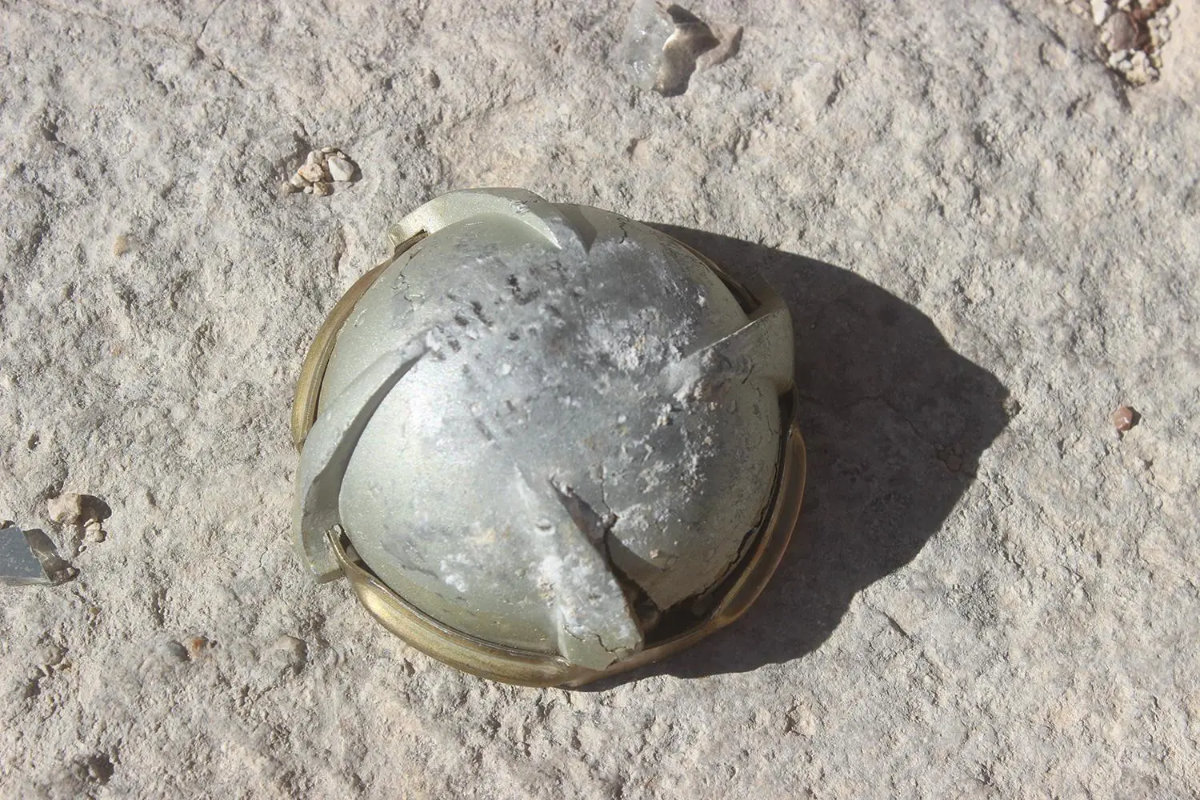
Among the most common unexploded ordnance found in the northwest Syrian Arab Republic are TM-62 Russian anti-tank mines and ShOAB-0.5 cluster bombs.
Despite HALO’s 35 years of work in safely clearing explosive remnants of war, the scale of the problem, compounded by a lack of adequate resources, remains a significant challenge.
“To cover the whole country, there will have to be thousands of Syrians trained and employed by HALO over many years,” said program manager O’Brien.
And until international and local efforts are effectively coordinated to neutralize this deadly threat, the lives of countless civilians, particularly children, will continue to be at risk.
